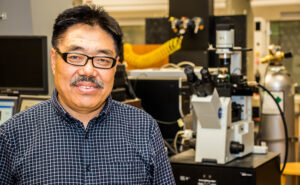
Bingqian Xu
A team of researchers, including a scientist at the University of Georgia, has developed a new method for designing and controlling the synthesis and self-assembly of giant supramolecules. The team’s work, described in the journal Nature Communications, could serve as a building block for the exploration of light-harvesting and light-emitting nanoelectronic devices, sensors and other nanomaterials with smart properties.
“This is a new, bottom-up method of creating nanomaterials,” said Bingqian Xu, a professor in UGA’s College of Engineering and a member of the research team. “By using a metallic ion to connect individual molecules we are able to precisely control the shape, size and dimensions of the nanostructure.”
 According to Xu, the research is notable because it’s the first time scientists have demonstrated the self-assembly of a giant metallo-supramolecular nanostructure, shaped like the six-pointed Star of David, using metallo-organic ligands (MOL’s). MOL’s are chemical compounds that contain metals and organic ligands (an ion or molecule that binds to a central metal atom).
According to Xu, the research is notable because it’s the first time scientists have demonstrated the self-assembly of a giant metallo-supramolecular nanostructure, shaped like the six-pointed Star of David, using metallo-organic ligands (MOL’s). MOL’s are chemical compounds that contain metals and organic ligands (an ion or molecule that binds to a central metal atom).
Ultimately, the process could allow scientists to design more complex nanostructures with specifically-tailored functionality.
“Compared to other self-assembled nano-structures utilizing material such as DNA, our approach is able to create a broader array of superstructures because of the high diversity of molecular building blocks and multiple intermolecular interactions at our disposal,” said Xu. “In addition, MOL’s are much more robust so the nanostructures will survive harsh environments.”
Xu’s collaborators on the project include Pingshan Wang of Central South University in China and Xiaopeng Li of the University of South Florida.
“This collaborative research represents a new and additional direction for our group,” Xu said. “I’m excited about exploring more complex and multifunctional nanostructures with smart properties as we move forward.”
The study, “Self-assembly of a supramolecular hexagram and a supramolecular pentagram,” is available online at https://www.nature.com/articles/ncomms15476.


